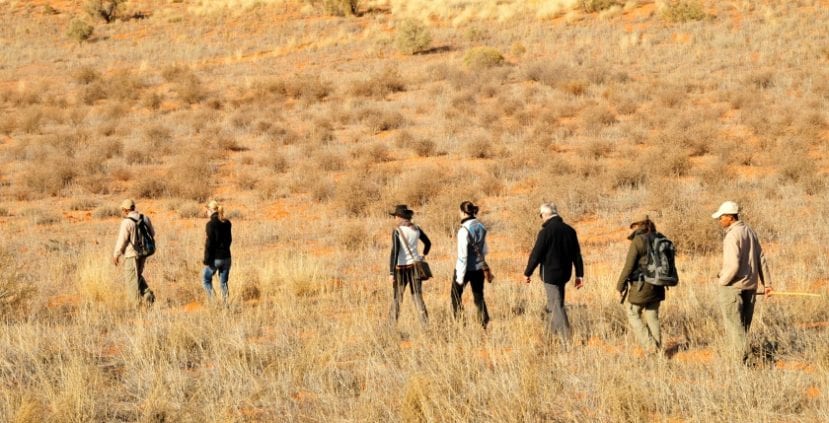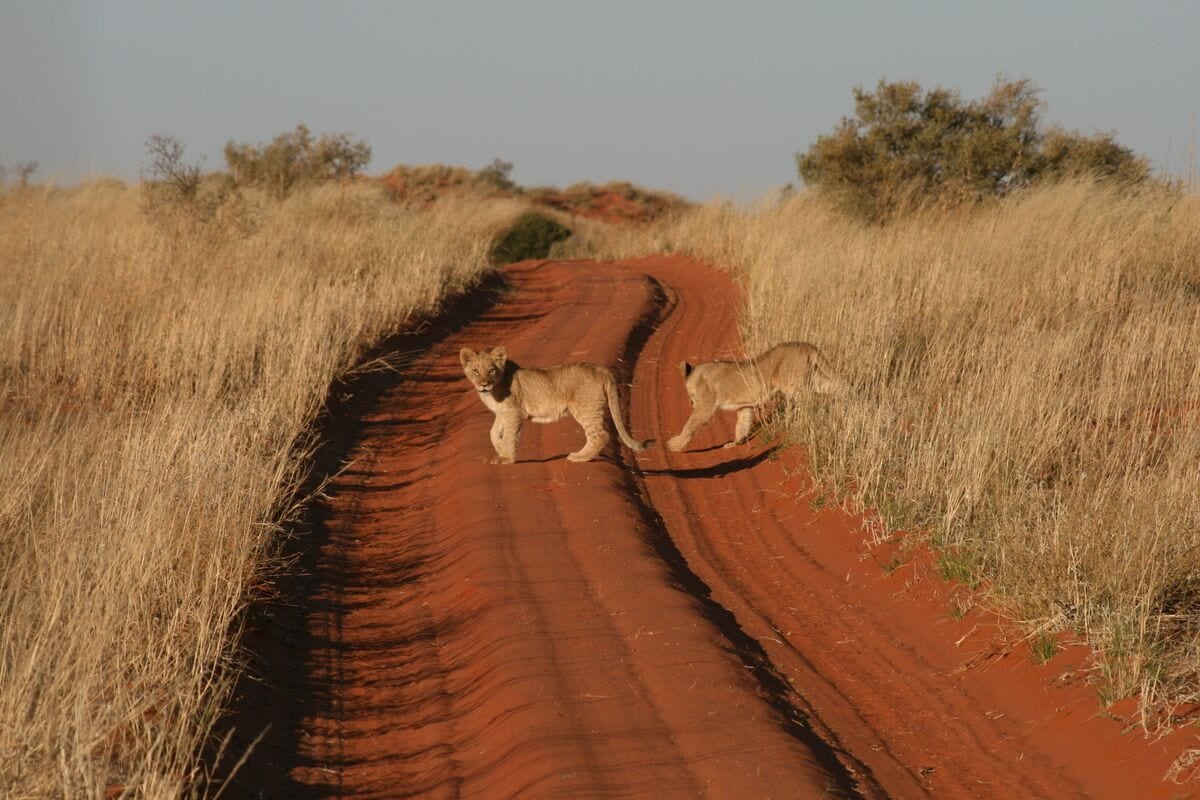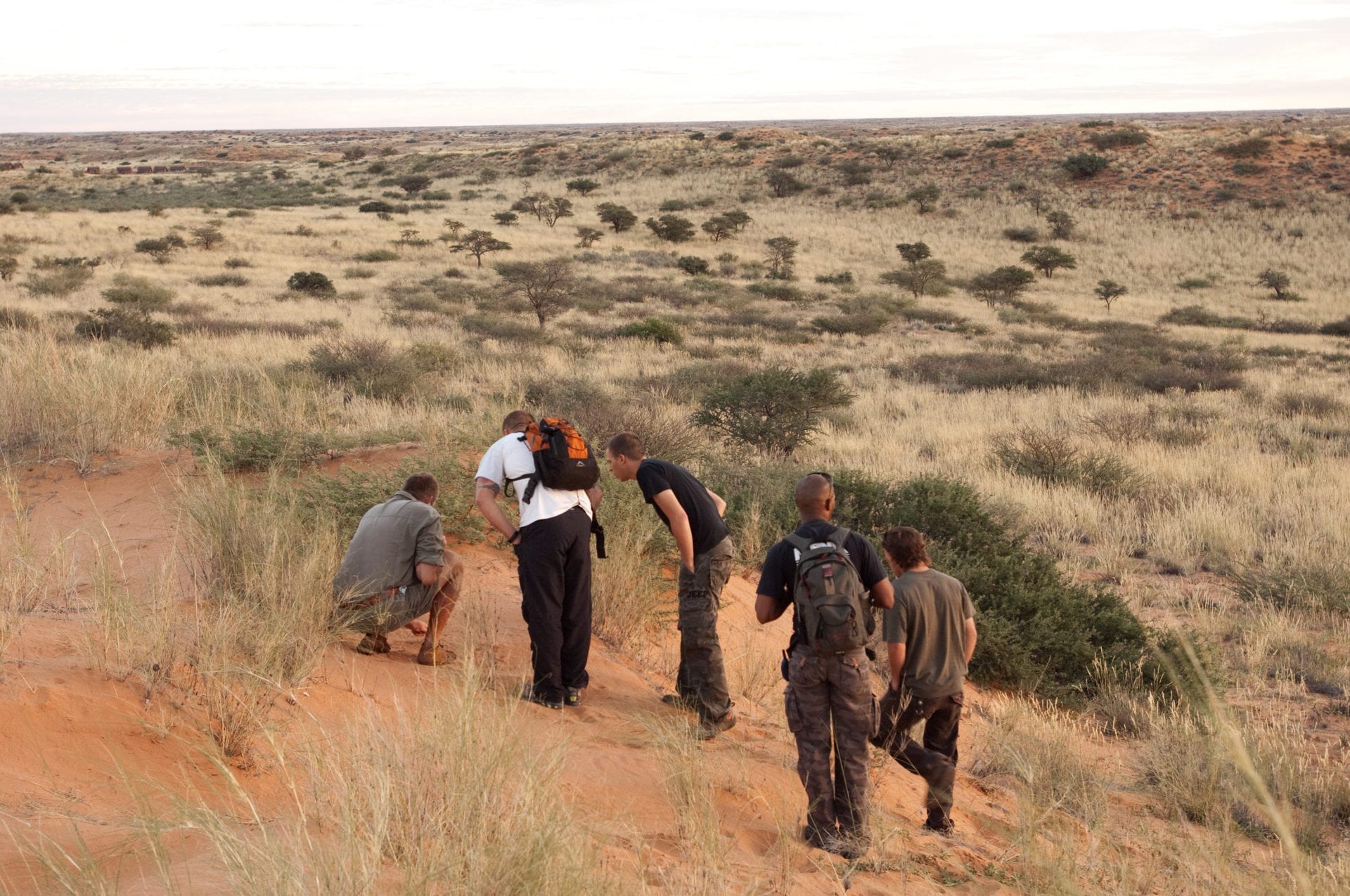
“17 lions, 2 leopards and more giraffes than you can shake a stick at,” said a middle-aged sunburnt man in Jo’burg departures.
With all the naive enthusiasm of a schoolboy playing Top Trumps, he showed off his safari scorebook to fellow travellers – feigning half-hearted interest – as they waited for bag-drop.
Suddenly, I got a disturbing image of a melee of safari vehicles accelerating raucously around the veldt, merely so that this man and his ilk could tick all the boxes in their safari book.
 My experience in the vast landscape of South Africa’s remote Northern Cape Province and Kalahari Desert had been quieter, slower, and more thoughtful. Just a few lions, plenty of giraffes, and probably not another safari vehicle for thirty miles.
My experience in the vast landscape of South Africa’s remote Northern Cape Province and Kalahari Desert had been quieter, slower, and more thoughtful. Just a few lions, plenty of giraffes, and probably not another safari vehicle for thirty miles.
This is an Attenborough hushed reverential tones landscape, a place of burnt-out colours, crushed terracotta sands, waving grasses bleached white and, after rare rains, occasional carpets of yellow desert bloom.
My safari was more respectful of the environment too. In the Kgalagadi, the world’s largest game park, which takes in huge swathes of both Botswana and South Africa – translating as “The Parched Land” – I had walked with a bushman. His semi-nomadic people had lived in this sun-bleached land for more than 20,000 years. Small burial cairns of rocks the only mark they have left.

The Khomani San, the indigenous people from the Kalahari Desert, survived in a harsh environment where its two rivers may “run” just once or twice a century. They call their home, “The place the devil made.” Their Indigenous Knowledge System, with an ability to survive and indeed thrive on scarce natural resources, has prompted UNESCO to recognise their specific ethnobotanical knowledge in an attempt to preserve the heritage of their cultural practices and world view.
 Just outside the Kgalagadi, at the Living Museum of the Khomani San, you can walk with a bushman for an hour or two or for a day or two.
Just outside the Kgalagadi, at the Living Museum of the Khomani San, you can walk with a bushman for an hour or two or for a day or two.
In his loin-cloth, carrying just a bow and some arrows, he leads us through the Kalahari Desert. At the Craft Village, a ten-minute walk across the salt pan from the Xaus Safari Lodge, you watch as a bushman creates that bow, painstakingly whittling an acacia branch for a day before adding the string, adapted from the dried tendon of a Gemsbok deer. The arrows would have been dipped in poison and the bushmen track their wounded prey until it drops, giving thanks to the Gods for the animal’s life before they ate.
The Khomani San have a different sense of time to the frantic, frenetic contemporary world. Their ancestors would have followed a bee for hours until they discovered its hive. If they lost the trail they would wait, sometimes for days, until the bee passed that way again.
 Patience’s reward was a beer brewed from honey and Social Weaver Bird droppings, a brew so potent that only the tribal elders were allowed to drink it. Dessert truffles, were another luxury, won by slaying pursuing a fox until it sniffed out the prize.
Patience’s reward was a beer brewed from honey and Social Weaver Bird droppings, a brew so potent that only the tribal elders were allowed to drink it. Dessert truffles, were another luxury, won by slaying pursuing a fox until it sniffed out the prize.
Yet this story is a tragedy, one where we sense a final denouement that will not deliver catharsis. In 1931 the South African government ruthlessly expelled the bushmen from their homeland to create a new National Park.
Over the following decades the Khomani San, dispersed over the farms of the Northern Cape, lost their identity: descending into alcoholism, depression and despair. Traditionally, the bush people believed that your spirit became a star when you died. Seeing new stars racing through the firmament they feared their ancestors were angry that their successors had lost their heritage. Of course, the agitated “stars” were satellites but the tale is symbolic of their angst.
 After the abolition of apartheid, the few dozen remaining Khomani San took the government to court for restitution of their ancestral lands. They won the case, receiving compensation and slithers of land on the fringes of the park.
After the abolition of apartheid, the few dozen remaining Khomani San took the government to court for restitution of their ancestral lands. They won the case, receiving compensation and slithers of land on the fringes of the park.
A walking safari with the Khomani San, the tribe we nearly lost, is an immense privilege. Schools for the tribe have bushcraft on the curriculum but visitors will sense that the tribe sits uneasily between the appeal of their heritage and the easy temptations of a 21st Century lifestyle of beer and burgers. If you visit South Africa’s Northern Cape Province take the chance to witness how mankind once lived well on so little.
There are several options in the area in terms of accommodation. Molopo Kalahari Lodge are single and double-occupancy self-catering chalets. As well as the Xaus Lodge with rates that includes all meals, game drives, wilderness walks, star gazing, a visit to the Bushman craft village and return transfers to the Kamqua picnic site.
 Beyond the lodges, there are several must-have experiences such as the authentic and unique “Bush” experience on the Khomani farm Witdraai in the beautiful Southern Kalahari dune belt for individuals and for groups. Vinkie’s Tourism Enterprise is an eco-tourism venture that specialises in tailour-made tours, offering individual attention and first-hand experience in the traditional arts of tracking, bushcraft, craft making, tasting traditional foods and hunting with bow and arrow, and San stories from elders.
Beyond the lodges, there are several must-have experiences such as the authentic and unique “Bush” experience on the Khomani farm Witdraai in the beautiful Southern Kalahari dune belt for individuals and for groups. Vinkie’s Tourism Enterprise is an eco-tourism venture that specialises in tailour-made tours, offering individual attention and first-hand experience in the traditional arts of tracking, bushcraft, craft making, tasting traditional foods and hunting with bow and arrow, and San stories from elders.
Guest will also want to visit the Kgalagadi Transfrontier Park as well during their visit.
With thanks to southafrica.net for their help.

